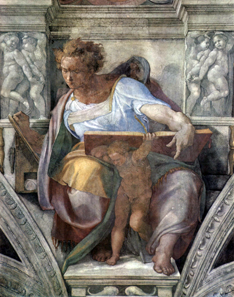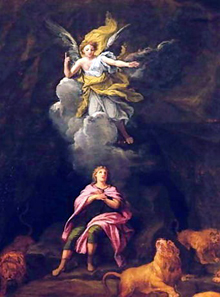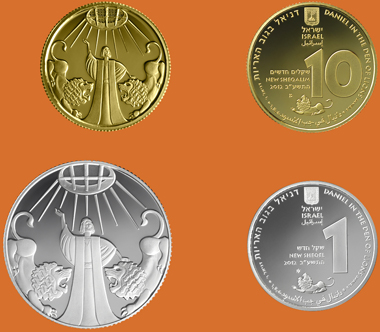January 3, 2012 – There are few stories in the Bible which are used as a metaphorical reference as much as that of Daniel in the Lion’s Den. The tale, from chapter 6 of the Book of Daniel, is an amazing one of faith, loyalty and heroism and was chosen by the Bank of Israel as the theme for the 17th annual issue in its Biblical Art Coin Series. (The 2010 Biblical Art Coin, ‘Jonah in the Whale’ won the prestigious international Coin of the Year Award ).
The coin is designed by Aharon Shevo. It has on the obverse the denomination, ‘Israel’ in English, Hebrew and Arabic, the date, Israel’s State Emblem and a hungry, roaring lion. The reverse is a stylized representation of Daniel, at the base of a sealed lions’ den, praying to the Lord, flanked but unharmed by two roaring lions.
The prophet Daniel in the Sistine Chapel, 1508-1512. Source: The York Project / Wikipedia.
Daniel was a handsome, intelligent boy of royal descent, who was exiled from his birthplace in the Land of Israel before the destruction of the First Temple in Jerusalem in 586 BCE. He grew up in the palace of King Nebuchadnezzar of Babylon, became a favorite of the King and later, the interpreter of the King’s dreams. For this, he was appointed head of the King’s wise men and the Kingdom of Babylon.
When Nebuchadnezzar died, his son Belshazar inherited the throne. One night, Belshazar made a great banquet for a thousand people (Book of Daniel, Chapter 5). After having had too much wine, he ordered that the vessels of the Temple in Jerusalem taken as plunder by his father, be brought out and used. At that very moment, a hidden hand began to write words on the wall. Nobody was able to interpret their meaning except Daniel. Only he was able to read and explain the significance of the writing: The words ‘Mene Mene Teqel Ufarsin’ predicted the fall of the Babylonian Empire and its conquest by Persia and Modai. That very night, Belshazzar was killed and Darius the Mede succeeded to the throne. Darius, like his predecessors, appointed Daniel as Head of his Counselors and in sole charge of the empire.
Daniel in the Lion’s den visited by an angel (detail) by Francois Verdier, 1651-1730. Source: Wikipedia.
Out of sheer envy, Daniel’s rivals then sought his downfall. A decree was initiated by the King’s Counselors with the King’s agreement, that no-one was to offer prayer to any god or man except him for a period of thirty days. Any person violating this decree would be thrown into the lions’ den. When Daniel remained faithful to God and continued praying to Him three times daily, his rivals spoke slander of him before the King, and despite his affection for Daniel, the King now had no choice but to have him thrown into the lions’ den.
That night, the King could not sleep and at the crack of dawn, he went to the lions’ den to see what had become of Daniel. To his relief and joy, Daniel, rewarded by God for his faith and loyalty, was there in the den, untouched by the fierce lions. The King admired the God of Daniel and decreed that He was to be revered. He ordered that Daniel’s rivals be thrown into the den, upon which they were instantly devoured by the lions. Daniel continued to serve as executive officer to Darius the Mede and later, Cyrus, King of Persia.
The coin shows Daniel in the Lion’s Den and is available in four different variants.
There are four variants (two gold and two silver) available: One of the gold coins is in the popular “smallest gold coins of the world” category, a 1/25 ounce .999 pure gold 1 New Sheqel measuring 13.92 mm. The three others are the traditional .917 gold (22 kt) 10 New Sheqel and sterling silver 2 and 1 New Sheqels.
Sets of all three coins and of the of two silver coins are also being offered.
For more information on all the coin and medal issues of Israel or to order online visit the website of the Mint of Israel.






